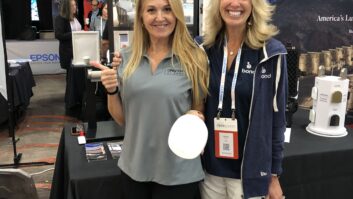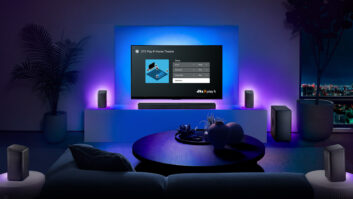NEW YORK – Tabletop wireless-multiroom speakers and streamers, at first glance, might seem to be targeted to entirely different customers and use cases than custom-installed home-automation systems.
But increasingly, electronic systems contractors (ESCs) are integrating the two types of systems to enable control of wireless-multiroom speakers and streamers from installed home-automation systems. And select home-control companies are cooperating with wirelessspeaker suppliers to make it happen.
Recently, Remote Technologies Incorporated (RTI) began offering two-way drivers to integrate Denon’s Heos wireless multiroom-audio speakers and streamers into RTI’s home-control systems, and Denon is working with additional home-control companies to integrate Heos products into their systems.
With the launch of free two-way drivers developed jointly by RTI and Denon, an RTI user interface lets consumers browse onlinestreaming and PC-stored music as well as adjust audio settings on up to 16 Heos speakers.
“We have a publicly available control API, and we work directly with control manufacturers, to get the best Heos experience up and running on their systems,” said Denon product manager Paul Belanger.
For its part, NuVo has developed drivers to enable control of its wireless multiroom-audio system from home-control systems made by Vantage, AMX, Control 4, Bitwise, Crestron and RTI. Most drivers were developed directly with the home-control suppliers, and a couple drivers were developed in cooperation with third parties and then certified by the home-control supplier, said spokesperson Desirée Webster. “We’ve made it easy for other manufacturers and integrators to control the system by opening our API for those efforts,” she added. In addition, installers have turned to third-party software companies that create drivers that integrate Sonos speakers and streamers into select home-control systems. Sonos doesn’t publish a control API or specification or work hand in hand with home-control companies to develop drivers, the company told TWICE. Though third-party driver developers are filling a market demand, there are risks, suppliers said. “All support needs to be backwards-engineered by the third party and then implemented,” one supplier said. “This means that Sonos could push an update one day that breaks compatibility with the third-party controller.” On top of that, “there are limitations with the various Sonos drivers out there, be it lack of music-services browsing, group control or just speed of the interface in general,” the supplier said.
Control4’s spokeswoman said the company has “dedicated considerable driverdevelopment resources towards integrating popular music distribution solutions like Sonos, NuVo and Linn DS, for example, into the Control4 system.” Control4 “will continue to look at this space and see how the market responds to popular examples to judge the viability of future integration,” she continued. Denon’s Heos system “is certainly a great new system with a lot of momentum behind it,” and Control4 “will have some upcoming news about Heos,” she added. Control4 last year purchased third-party driver developer Extra Vegetables and redirected its resources to working on projects that integrate otherbrand products into Control4 home-automation systems.
Regardless of how homecontrol systems are integrated with wireless multiroom-audio products, installers have found multiple applications that make such integration pay off.
“An advantage of these wireless multiroom systems is they do provide the opportunity to utilize their wireless nature, allowing a player/speaker to be installed in rooms that are not wired for speakers due to retrofit or wirepulling challenges,” said RTI’s Brett Stokke. “With integration offerings such as Denon Heos, NuVo Wireless systems and Sonos, the sound quality keeps increasing, making these a viable alternative for RTI dealers,” he said.
NuVo’s Webster agreed that wireless-multiroom speakers offer retrofit potential in homes with previously installed home-control and previously installed wired multiroom-audio systems. Installers “can add zones where you may not have previously wired, and you can retrofit homes pretty easily when a system didn’t previously exist. Overall, it’s a flexible solution that just fits the different circumstances that the installer runs into.” A majority of integrated installs, however, use wireless audio in a completely different way: as a streaming-audio source in a wired multiroom audio system, Stokke said. “The player or players actually reside in the rack, hard-wired to the [wired] multiroom-audio system and the network [via Ethernet cable]. In this way, dealers provide clients with access to their favorite streaming services, in addition to other audio sources, in any zone via a single control interface.”
The solution allows control systems to easily integrate popular streaming services that the control systems themselves don’t access, he continued.
Such installs also deliver the advantages of hardwired multiroom audio systems, including higher power, higher performance in-wall and in-ceiling speakers, and elimination of the possibility of Wi-Fi issues interrupting a song, Stokke said.
In some cases, installers add the amplifier/streamers of wireless audio systems into their equipment racks to directly drive in-wall and in-ceiling speakers. For such applications, suppliers could in the future develop a rack-mountable chassis incorporating multiple amp/streamers.













